Chinese Name: 西安钟楼 Pronunciation: xī ān zhōng lóu
Building Time: A.D 1387
Park Area: 1,377 square meters
Suggested Visiting Hours: 1 Hour
Best Visiting Time: All year round
Building Function: Work as an alarm tower to defend the alien invaders
Address: Junction of East Avenue and South Avenue, Lianhu District, Shaanxi Province
| Tickets | Single Ticket | Joint Ticket ( The Bell Tower and the Drum Tower) |
| Adult | 30 yuan | 50 yuan |
| Children under 1.2 meters | 0 | 0 |
| Xi’an Bell Tower | Peak Season April 1st-October 10th |
Low Season October 11st-March 31st |
| Opening Hours | 8:30-21:30 | 8:30-18:00 |
| Ticket Office Opening Hours | 8:30-21:00 | 8:30-17:30 |
| Joint Ticket Office Opening Hours | 8:30-19:00 | 8:30-16:30 |

Xi’an Bell Tower was built in the Ming dynasty, A.D 1384. In the past, there was a bell in the tower for alarm. So it was called the Bell Tower. Xi’an Bell Tower is near the Drum Tower. It also became the landmark of Xi’an when it was built.
The Bell Tower is mainly made of brick and wood. It is built on the square base made of black brick.
From the ground to the roof, the total height is 36 meters. The Bell Tower includes three parts: the base, the building body and the roof. The square base is 8.6 meters high, 35.5 meters long on each side, covering an area of about 1,377.4 square meters. There is a staircase inside, you can climb up the stairs and explore the tower from there.
Based on the square base, there is the body of the building--a two-story wooden structure. The two-story wooden structure is made of the surrounding columns and cloisters, and cornices. It is 27 meters high. On the first floor, there is a hall, with doors all sides. And in the hall, there is colored drawing sunk panels on the ceiling. On the second floor, there are doors and windows made of wood that opened onto the veranda.

The roof of Bell Tower is a pyramidal roof structure. The roof was originally covered by copper, with the wooden structure in it. After China’s liberation, with the help of the people’s government, the roof was replaced by the gold platinum one. There are dark green glazed tiles covered on the cornices.
There are 6 meters high and wide doors at all four sides of the base. In the past, these four doors were linked to the East, South, West and North Avenues. People and vehicles could go through the four doors. However, now, with the development of urban construction, these four doors cannot adapt to the traffic flow so they were closed.
The original site of Xi’an Bell Tower was not here. In A.D 1582, the grand coordinator of Shaanxi asked the magistrates of Chang’an to move the original Bell Tower into the city center. That is the present site of Xi’an Bell Tower.

Xi’an Bell Tower is located in the center of Xi’an, the interchange of the East, South, West and North avenues. It is the biggest, the most well-preserved bell tower in Chinese history.
Xi’an Bell Tower was built in A.D 1384. It was first built at Guangji Street, facing the South and North Gates or the Ming City Wall. At that time, the Bell Tower was on the central axis of Chang’an city (now Xi’an city), the city center.
During the following two hundred years, with the development and extension of Chang’an city, the city center moved to the east and the New Four Avenues of East, South, West and North were formed. The Bell Tower was gradually far away from the city center. In 1582, the grand coordinator Gong Maoxian ordered to move the Bell Tower east to the city center. On the west wall of the second floor of Bell Tower, there was a stele called “Song of the Bell Tower moved to the east”, which recorded the moving history of Xi’an Bell Tower.
In the 38th year of Kangxi reign in the Qing Dynasty (1699), the 5th year of Qianlong reign (1740), and the 20th year of Daoguang reign (1840), the Bell Tower was renovated in a large scale.
In the Revolution of 1911, the insurrectionary army had a battle with the fortified Qing Army at Xi’an Bell Tower.
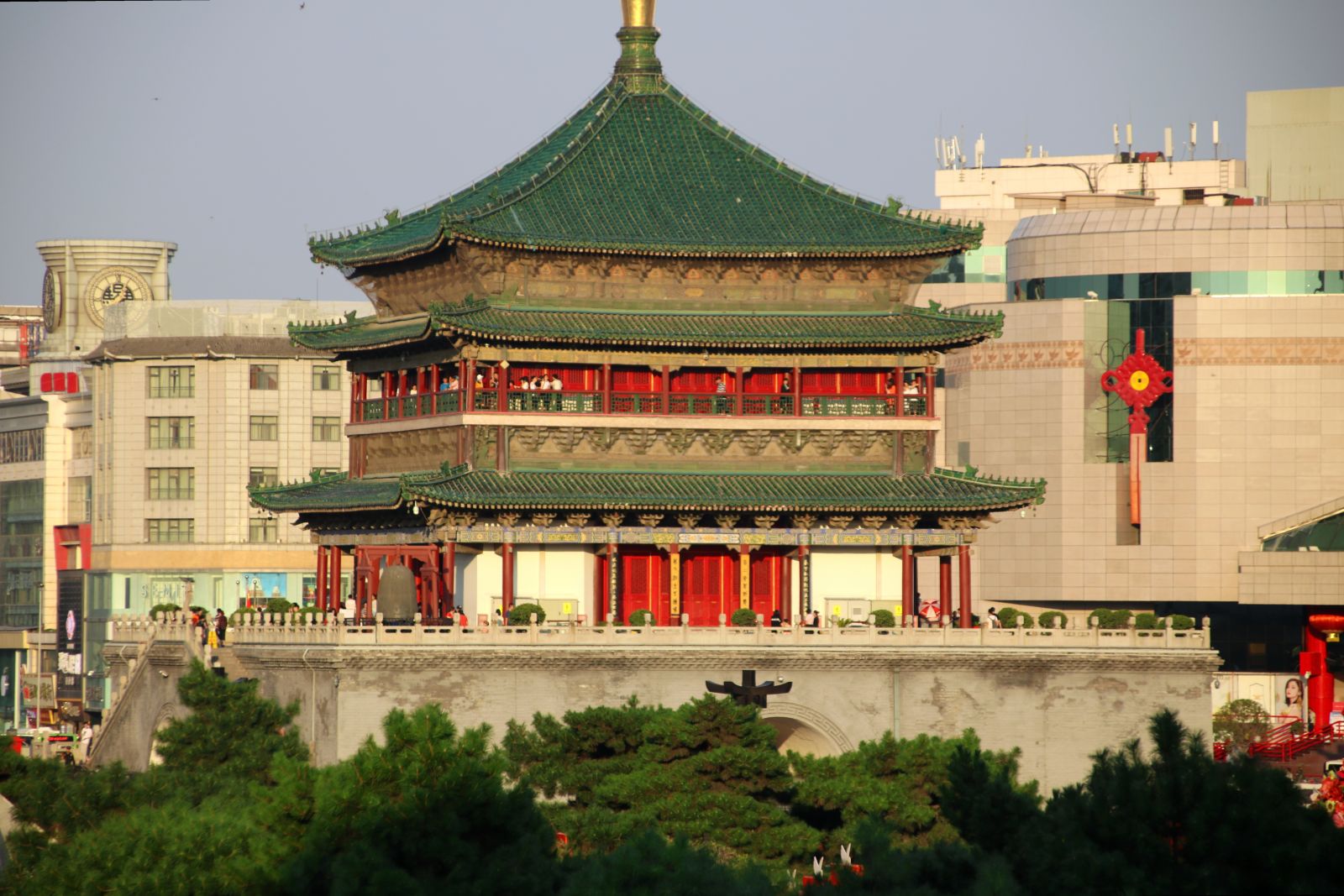
In the National Protection Movement, Chen Shufan, the military governor of Shaanxi province in the early days of the Republic of China, started the rebellion against Yuan Shikai from the Xi’an Bell Tower.
In 1927, Shilin, an overseas student from the United States, opened a cinema in Xi’an Bell Tower. It was the first cinema in the history of Xi’an.
During the Anti-Japanese War period, because of the high terrain, the Bell Tower became the alarm station to warn the air attack of the Japanese army.
On August, 6th, 1956, Shaanxi Provincial People’s Committee announced Xi’an Bell Tower as the provincial cultural heritage site.
On November 20th, 1996, Xi’an Bell Tower was selected as the Key National Heritage Protection Units by the State Council.
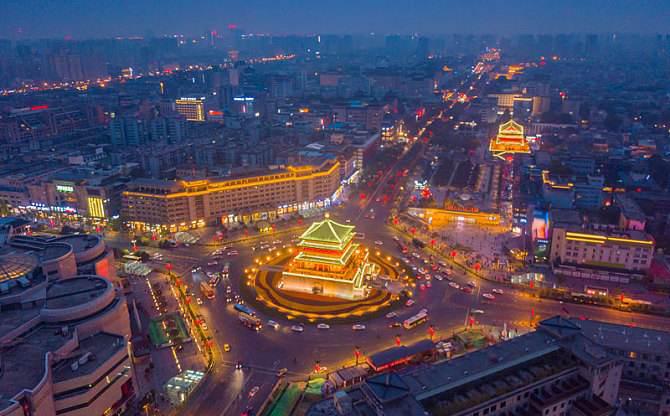
Xi'an Bell Tower is the iconic building of Xi'an city. It has received many national leaders such as Zhu De, Chen Yi, Zhou Enlai, Deng Xiaoping and many famous Chinese and foreign people.
Many exhibitions were successfully hosted in Xi’an Bell Tower. The exhibitions include the Qi Baishi Painting Exhibition, the Exhibition of Celebrity Calligraphy and Painting in the Ming and Qing Dynasties.
In April 2006, Xi'an Bell Tower won the silver medal in the selection of 50 scenic spots in China that foreigners cannot miss.
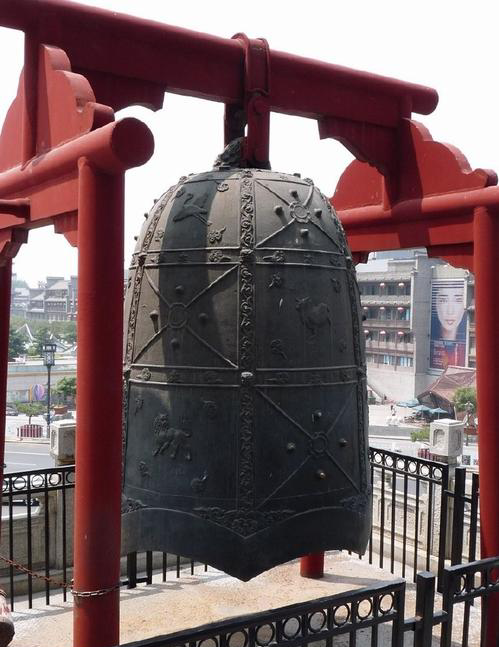
The bell hung in the northwest corner of the Bell Tower is no longer in service for reporting time. However, in Chinese New Year, it would still be sounded to pray for peace. The present bell in the Bell Tower is the imitation of Jing Yun Bell.
Jing Yun Bell was cast in the 2nd year of Jing Yun reign in the Tang Dynasty (711). Tang Ruizong (the fifth emperor of the Tang Dynasty) personally wrote inscriptions for it. The diameter of Jing Yun Bell is 1.5 meters. And it is two meters high and weighs ten thousand Jin (a unit of weight, 1/2 kilogram). In the past, it was used for giving the correct time.
China National Radio has recorded the sound of Jing Yun Bell, and played the bell tone at the CCTV Spring Festival Gala Evening to welcome the New Year.
In 2000, Jing Yun Bell was printed on Chinese stamps. It was praised as "the first bell in the world ".
In the Anshi Rebellion (a war in the late Tang Dynasty), the Bell Tower was destroyed and turned into ashes. The Jing Yun Bell was also abandoned. In the Ming Dynasty, the Bell Tower was rebuilt on its original site. And Jing Yun Bell was available once again.
In the 10th year of Wanli reign in the Ming Dynasty (1582), the Bell Tower moved east to the city center. In order to move Jing Yun Bell to the new Bell Tower, an inclined bridge was built in the west section of West Avenue. So Jing Yun bell could be transported to the Bell Tower by the slope of the bridge.
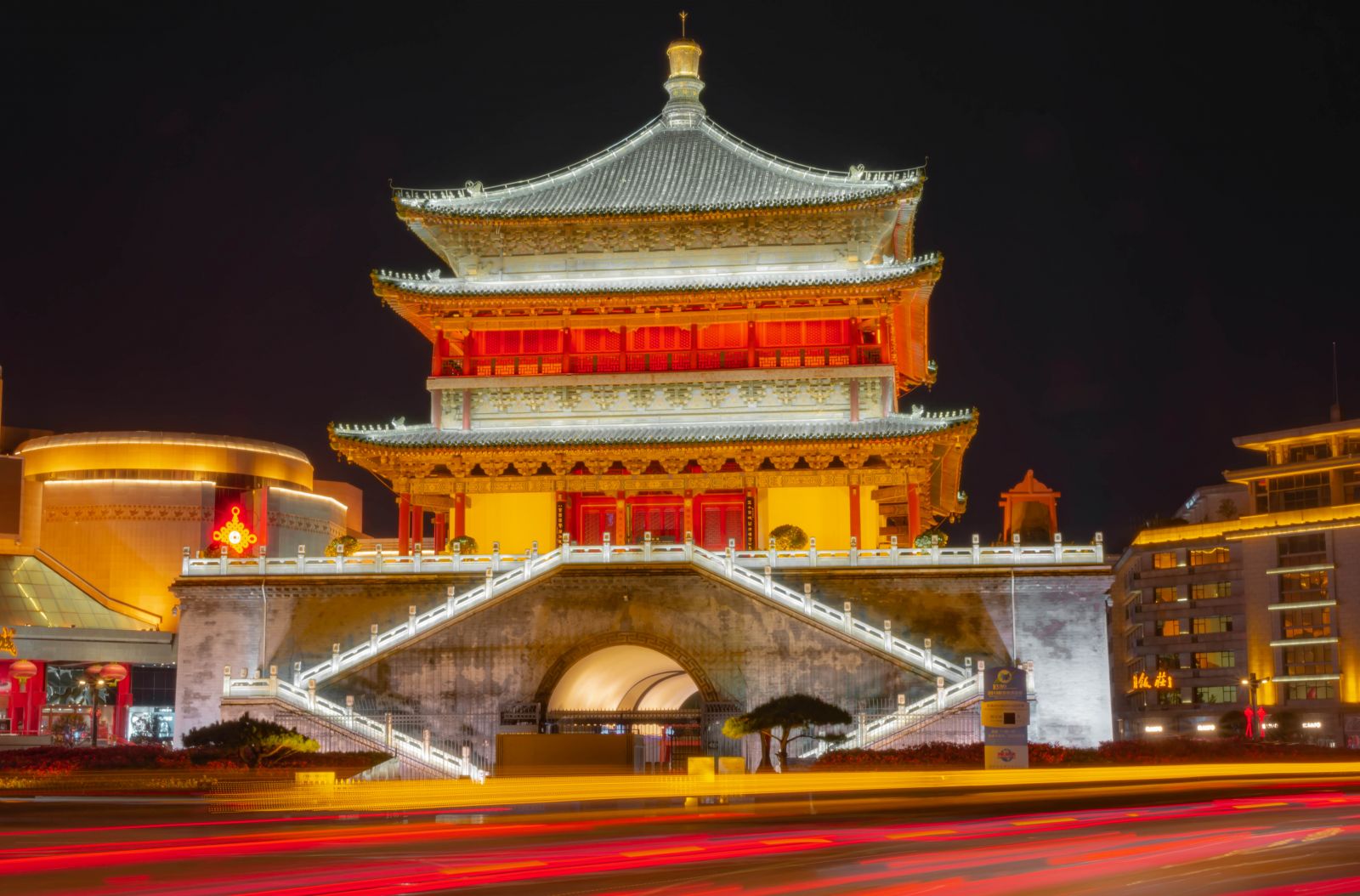
Strangely, although the size of the Bell Tower had not been changed, Jing Yun bell could not ring anymore. There were many reasons why Jing Yun Bell didn’t ring. Some people thought it showed Jing Yun Bell would not like to be moved, while others said that the Jing Yun Bell should not place in the room but outside. In any case, this added a layer of mystery to the history of the Bell Tower.
In 1996, Xi'an government decided to imitate Jing Yun Bell of the Tang Dynasty. The imitation of Jing Yun bell looks similar to the original one in appearance, with a height of 2.45 meters and a weight of 6.5 tons. The outer diameter of the bell is 1.65 meters. The ornaments and inscriptions are the same as the original bell. However, the sound is louder and more powerful than the original one.
On 30th January 1997, the bell rang again in ancient Xi’an after hundreds of years in silence. Now, the imitation of Jing Yun Bell hangs in the northwest corner of Xi’an Bell Tower.
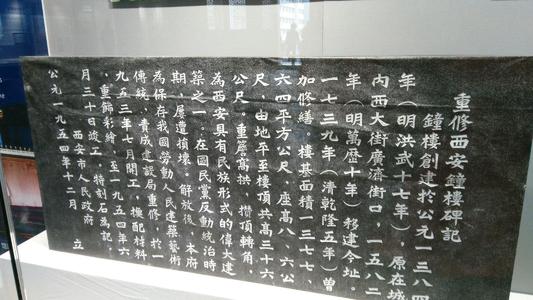
On the first floor of Xi’an Bell Tower, there are three tablet inscriptions on the west wall in the hall.
The first tablet inscription recorded the renovation of Xi’an Bell Tower by Xi'an Municipal People's Government in 1953.
The second one recorded the rebuilding of Xi’an Bell Tower in the 5th year of Qianlong in the Qing Dynasty (1740). And the inscriptions on the tablet were written by the governor of Shaanxi province of the time, Zhang Kai.
The third one recorded the move to the east of Xi’an Bell Tower in the 10th year of Wanli reign in the Ming Dynasty (1582). The inscriptions on the third tablet were written by the grand coordinator of Shaanxi province of the time, Gong Maoxian.
The whole view of Xi’an Bell Tower→Jing Yun Bell→Tablet Inscriptions
Take bus 4, 6, 7, 11, 12, 15, 16, 26, 29, 32, 35, 36, 37, 43, 45, the south of 46, 118, 201, 203, 208, 215, 218, 221, 222, 229, 235, 251, 252, 286, 300, 600, 603, 604, 605, 606, 608, 609, 611, 612, 616,622 and Travel 7and 8(610), and get off at Xi’an Bell Tower Station.
By Subway
Take metro line 2, and get off at the Xi’an Bell Tower Station
By Taxi
Chinese: 请带我去西安钟楼。English: Please take me to the Xi’an Bell Tower.
If you go to Xi’an Bell Tower from Xi’an Railway Station, it takes about 15 minutes. (about 13 yuan)
If you go to Xi’an Bell Tower from Xi’an South Railway Station, it takes about 50 minutes. (about 72 yuan)
If you go to Xi’an Bell Tower from Xi’an North Railway Station, it takes about 51 minutes. (about 65 yuan)
If you go to Xi’an Bell Tower from Xi’an Xianyang International Airport, it takes about 56 minutes. (about 105 yuan)
